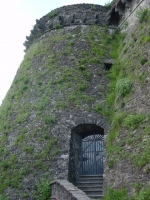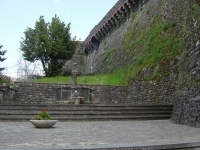Map
Camporgiano
Unione dei Comuni - Comune di Camporgiano
History
Medievale feud, the territory was disputed between Pisa and Lucca. Lucca became the owner in the thirteenth century. Passed to the Florentines in the fifteenth century was Estense dominion.
The fortress, La Rocca
 Fortified medieval (fourteenth century), originally consisted of a small structure,
with thin walls and high, to guard the valley of the river Serchio.
Fortified medieval (fourteenth century), originally consisted of a small structure,
with thin walls and high, to guard the valley of the river Serchio.
Following the dedication of the Community of the Camporgiano to the Estensi became a vicaria. The old fort was completely renovated with the construction of a thick curtain walls in stone, set against the medieval walls, and the realization of two cylindrical towers at the service of the artillery.
Inside the walls, in addition to the endowments of the military, there were buildings for housing and a small church. There is a collection of medieval and Renaissance ceramics.
The fortress was abandoned following the disastrous collapse during the earthquake of 1920.
 Ancient stone fountain;
Ancient stone fountain;
Church of San Iacopo: keep one of the wooden sculpture of Andrea Pisano.
Archaeological Museum.
Camporgiano is famous for the International Folklore Festival, where groups of international renown from all continents are alternated for several evenings.
Photos of the village
Fractions, administrative division of a municipality:
POGGIO: Church of St. Biagio (Esc. XII).
PUGLIANELLA: Village between the Tambura and the Penna di Sumbra.
ROCCALBERTI: Nucleus fortified.
VITOIO: Romanesque church: pairs altar of the fifteenth century.
Tradition: elves: Il buffardello.
History
Medievale feud, the territory was disputed between Pisa and Lucca. Lucca became the owner in the thirteenth century. Passed to the Florentines in the fifteenth century was Estense dominion.
The fortress, La Rocca

Following the dedication of the Community of the Camporgiano to the Estensi became a vicaria. The old fort was completely renovated with the construction of a thick curtain walls in stone, set against the medieval walls, and the realization of two cylindrical towers at the service of the artillery.
Inside the walls, in addition to the endowments of the military, there were buildings for housing and a small church. There is a collection of medieval and Renaissance ceramics.
The fortress was abandoned following the disastrous collapse during the earthquake of 1920.

Church of San Iacopo: keep one of the wooden sculpture of Andrea Pisano.
Archaeological Museum.
Camporgiano is famous for the International Folklore Festival, where groups of international renown from all continents are alternated for several evenings.
Photos of the village

Fractions, administrative division of a municipality:
POGGIO: Church of St. Biagio (Esc. XII).
PUGLIANELLA: Village between the Tambura and the Penna di Sumbra.
ROCCALBERTI: Nucleus fortified.
VITOIO: Romanesque church: pairs altar of the fifteenth century.

Tradition: elves: Il buffardello.